Nautic Alert, excellence in monitoring and control
While my boat, thankfully, doesn’t need six bilge pumps like the system above, four months of serious testing has left me deeply impressed with the Nautic Alert bilge, battery and GPS precision sensor platform. Yes, it also manages one pump or many — probably better than any us ever will — and it clearly informs a skipper of problems whether you’re on board or off. Finally, Nautic Alert regularly assures me that all is well, and it’s ripe for expansion. I think I’m in love…
First, let’s meet the developers. Nautic Alert is part of a family-run company called Market Spectrum, Inc. where the family trade is information technology (IT), while the family passion is boating. One key chapter to the story is how the father, Fernando Velado, lost his sailboat to an untended fire on a nearby vessel, even though he made a weekly two-hour roundtrip to the marina to make sure his own boat’s systems were working properly. Second was when the son, Nick, left his position as a BIOS engineer in the IBM SystemX server group to join his dad full time and create the protective system he’s showing off at the 2016 NMEA conference above.
Actually, at NMEA I already knew that Nick Velado had been working on the Nautic Alert platform for at least two years, and that helped explain the stellar level of smart and reliable detail I later encountered in my testing. However, it was only last week that I learned he once helped design the critical Basic Input/Output Software for a well-known line of critical servers, but that certainly makes sense, too.
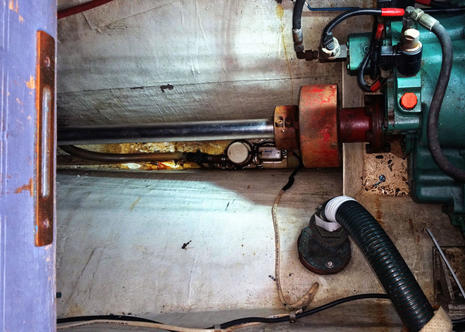 I’ll also mention how motivated my Nautic Alert testing has been. Just as I was about to install the system, various events indicated that I had gotten quite sloppy about what is arguably the most basic tenet of successful seamanship. There I was happily thinking of Gizmo as a dry boat with a good redundant automatic bilge pump system — that’s the primary deep in the aft bilge above, and there’s a larger fully independent backup pump forward of the engine. But, in fact, I was operating for at least a few weeks last summer with neither bilge pump functional and a dripless shaft seal that was about to let go in a very wet way.
I’ll also mention how motivated my Nautic Alert testing has been. Just as I was about to install the system, various events indicated that I had gotten quite sloppy about what is arguably the most basic tenet of successful seamanship. There I was happily thinking of Gizmo as a dry boat with a good redundant automatic bilge pump system — that’s the primary deep in the aft bilge above, and there’s a larger fully independent backup pump forward of the engine. But, in fact, I was operating for at least a few weeks last summer with neither bilge pump functional and a dripless shaft seal that was about to let go in a very wet way.
What happened and what I learned in the diagnostic and repair process are worth the planned future entry, I suspect, but for now just please remember what I forgot: Boats can figure out many ways to leak and bilge pumps many ways to fail.
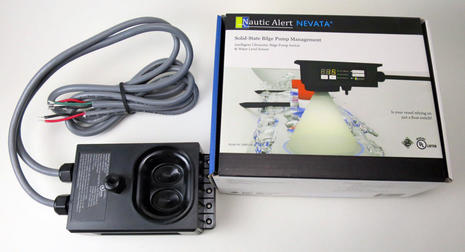 There are two main hardware components to the full Nautic Alert platform, and the Nevata bilge pump switch and controller can be used by itself. My photo shows the ultrasonic sensor that constantly watches the water level, and also the heavy duty cables that connect to a boat’s 12, 24 or 32 volt supply and to the bilge pump. Actually that’s the $449 Nevata 2R model that can manage two pumps, but in either case replacing existing pump switches should not be hard, and this one is not just solid state. It’s intelligent, faithful, and well spoken.
There are two main hardware components to the full Nautic Alert platform, and the Nevata bilge pump switch and controller can be used by itself. My photo shows the ultrasonic sensor that constantly watches the water level, and also the heavy duty cables that connect to a boat’s 12, 24 or 32 volt supply and to the bilge pump. Actually that’s the $449 Nevata 2R model that can manage two pumps, but in either case replacing existing pump switches should not be hard, and this one is not just solid state. It’s intelligent, faithful, and well spoken.
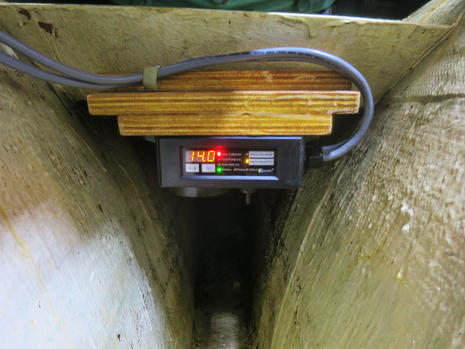 Nevatas may well be the most expensive bilge pump switches in the world, but don’t presume a value judgment until you understand all they can do. Once I’d completed this temporary install in Gizmo’s aft bilge, I easily used the switch’s button and LED interface to invoke the Auto Calibrate mode, which meant it used its abilities to “hear” the water level and sense the current passing through the pump to establish its precise pump-dry level. (14.0 inches is the distance between the Nevata and the bilge water level or floor, and the screen can be set to show either that value, water height or accumulated pump cycles.)
Nevatas may well be the most expensive bilge pump switches in the world, but don’t presume a value judgment until you understand all they can do. Once I’d completed this temporary install in Gizmo’s aft bilge, I easily used the switch’s button and LED interface to invoke the Auto Calibrate mode, which meant it used its abilities to “hear” the water level and sense the current passing through the pump to establish its precise pump-dry level. (14.0 inches is the distance between the Nevata and the bilge water level or floor, and the screen can be set to show either that value, water height or accumulated pump cycles.)
Lucky guy that I am, Gizmo’s semi-failed shaft seal remained dripless under about 7 knots, and so for a few days I was able to sit about where I took this photo (holding the camera beneath the prop shaft) and easily control a steady flow of water into the bilge. That’s how I became confident that the Nevata can consistently measure water depth to 0.1 inch accuracy, and I also watched several times as it responded instantly to the (customizable) 2-inch pump-on level by running the pump exactly to when it started sucking air.
There’s much more the Nevata can do, especially when the internal that little down-pointing (ZigBee) wireless antenna is talking to a Nautic Alert Insight display and offboard communicator, but I’ll add one note before we leave Gizmo’s bilge area. I’ve been underway a few times since this install and during one fast, bumpy run the Nautic Alert generated some false high bilge level alarms. That’s when I learned about the anti-slosh logic that Nick Velado engineered into the Nevata and also that I had installed it wrong. Observe that the whole device is on center, when actually the ultrasonic sensor should be centered for the cleanest, least splashy view of this narrow bilge area. I could also add a tube to accomplish the same goal, but I’m pretty confident that refastening the Nevata in the right place will end false alarms. {Correction: the little visible “antenna” is the temperature sensor, which also used to calibrate the speed of sound from the ultrasonic transducers.}
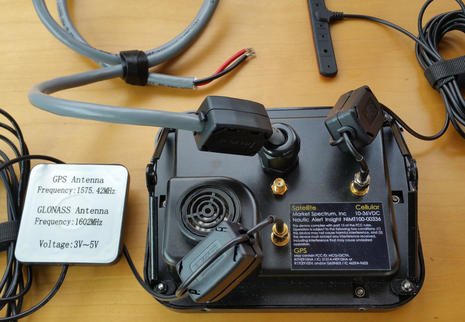 I can imagine using a Nevata standalone, especially if it could be installed in a more visible location than mine, but I have to add that when I recently sent this test Nautic Alert Insight in for a firmware update, I missed it every single day of the roundtrip. The Insight adds yet more intelligence to the Nevata bilge management, plus GPS and battery monitoring, plus data display, louder alarming onboard, and remote alarming with a service plan. That is a 95dB siren on the backside, which makes a lot more noise than what’s typically built into MFDs and other displays, and an external audio alarm is also supported (and both can be muted).
I can imagine using a Nevata standalone, especially if it could be installed in a more visible location than mine, but I have to add that when I recently sent this test Nautic Alert Insight in for a firmware update, I missed it every single day of the roundtrip. The Insight adds yet more intelligence to the Nevata bilge management, plus GPS and battery monitoring, plus data display, louder alarming onboard, and remote alarming with a service plan. That is a 95dB siren on the backside, which makes a lot more noise than what’s typically built into MFDs and other displays, and an external audio alarm is also supported (and both can be muted).
In this photo you can also see the GPS and Verizon 4G LTE cellular antennas that come stock with the $750 Insight (prices updated 7/17), though higher performance antennas are possible. But that “Satellite” port is just a dummy. While there will soon be an Iridium model of the Insight, and it will use the same case with similar service plan choices, customers will have to choose between cell or satellite communications at purchase.
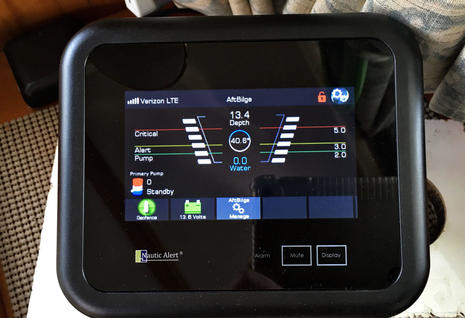 The Insight’s 4.3-inch, 480 x 272 pixel touchscreen is hard to photograph but great to use, and I also find the interface very friendly. Note, for instance, that when I selected this Nevata bilge screen, its button immediately flipped to Manage mode so two taps would have gotten me to the sensor’s setup screen, and all use my “AftBilge” custom Nevata name. I have a more interesting main Nevata screen further down, but note for now that when attached to the Insight, the Nevata delivers bilge temperature as well as water level.
The Insight’s 4.3-inch, 480 x 272 pixel touchscreen is hard to photograph but great to use, and I also find the interface very friendly. Note, for instance, that when I selected this Nevata bilge screen, its button immediately flipped to Manage mode so two taps would have gotten me to the sensor’s setup screen, and all use my “AftBilge” custom Nevata name. I have a more interesting main Nevata screen further down, but note for now that when attached to the Insight, the Nevata delivers bilge temperature as well as water level.
That temperature — also available via phone texting or on my Nautic Alert web portal — has been very valuable to me, trying as I am to keep my boat commissioned through a Maine winter, and worried as I am about how a freeze/break/thaw seacock scenario could sink my beloved boat almost as fast as a 4G text message. And given the wild climate fluctuations that have so far made my experiment nearly pleasurable, remote bilge temperature might be valuable in places where winter in-water storage is more common, but so are polar vortexes.
I did have a small problem with the ZigBee wireless connection between the Nevata and the Insight, but that’s mainly because my install meant that it had to pass diagonally and lengthwise through a substantial 450hp Volvo Penta diesel to reach the helm spot where I first mounted the display. It worked most of the time, but sometimes alerted me to short disconnects. But it was easy to move the Insight to the aft corner of the main cabin, where it also got a direct power connection to Gizmo’s battery bank — better for DC monitoring — and where it and its antennas can hide behind the curtains in case some bad hombre tries to violate my geofence. (Also the latest Insight firmware “adjusts the wireless heartbeat message timeout parameters” to reduce spurious disconnect alerts.)
Incidentally, throughout this process I could check on the Insight’s precise wireless connection to the Nevata, even by phone. In fact, I can tell you that the signal strength is a solid 61% right now. That’s the Velado way.
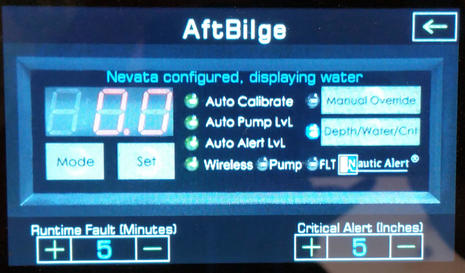 The Insight’s interface is pleasantly consistent throughout, except that the Manage Nevata screen understandably mimics the sensor/controller’s own interface. So I can manually run the pump from here, as well as autocalibrating, setting the pump-on level (Alert is 1 inch higher), and more. Plus, I can set the Critical Alert level and what I think is the critical Runtime Fault value.
The Insight’s interface is pleasantly consistent throughout, except that the Manage Nevata screen understandably mimics the sensor/controller’s own interface. So I can manually run the pump from here, as well as autocalibrating, setting the pump-on level (Alert is 1 inch higher), and more. Plus, I can set the Critical Alert level and what I think is the critical Runtime Fault value.
A situation that has sunk boats despite high water alarms, cycle counters, and even remote monitoring, is when a pump starts running for long periods trying to keep up with a sudden leak and eventually kills the battery. But if Gizmo’s primary pump runs more than 5 minutes continuously, my phone is going to vibrate and chime with the alert and/or I’ll hear the Insight siren fire off (especially if I install the remote alarm on the flybridge).
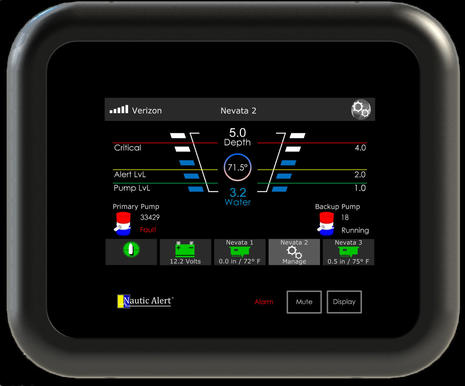 This is Nautic Alert’s own screen photo and I believe it’s showing the six-bilge-pump system diagrammed at the top of the entry. The three Nevatas should and could be named for the sections of the boat where they preside, but you can see how the primary pump controlled by Nevata 2 has failed, allowing bilge water to rise above the Pump and Alert levels, but that the backup pump is now taking care of it…all automatically.
This is Nautic Alert’s own screen photo and I believe it’s showing the six-bilge-pump system diagrammed at the top of the entry. The three Nevatas should and could be named for the sections of the boat where they preside, but you can see how the primary pump controlled by Nevata 2 has failed, allowing bilge water to rise above the Pump and Alert levels, but that the backup pump is now taking care of it…all automatically.
I don’t know exactly how that (test?) pump failed (after 33,429 cycles, at least since the last Nevata auto calibration), but I do know that the Nevata can detect over and under current situations as well as the fact that a running pump really isn’t pumping. It also tests the one or two pumps it’s managing weekly, and it knows not to try pumping frozen water. When we Sail magazine judges gave Nautic Alert a 2017 Pittman Award, I wrote that it’s like having “a tireless mate who constantly minds the bilge, manages the pumps intelligently, and lets you know what’s happening…” and I hope you’re convinced.
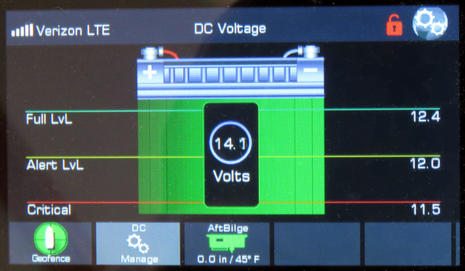 Nautic Alert Insight battery bank monitoring is also sweet, and again my winter in-water experiment provided a good testing situation. I only recently was able to borrow the tool needed to adjust Gizmo’s Victron MultiPlus inverter/charger to provide the correct float voltage to her new Firefly battery bank, so I’ve only been using shore power when I was on the boat. It’s like when she is on the mooring; I want to be alerted about low voltage, and I also want to be able to check from wherever I am if I’m concerned. This is not as simple as it sounds, but Nautic Alert delivers.
Nautic Alert Insight battery bank monitoring is also sweet, and again my winter in-water experiment provided a good testing situation. I only recently was able to borrow the tool needed to adjust Gizmo’s Victron MultiPlus inverter/charger to provide the correct float voltage to her new Firefly battery bank, so I’ve only been using shore power when I was on the boat. It’s like when she is on the mooring; I want to be alerted about low voltage, and I also want to be able to check from wherever I am if I’m concerned. This is not as simple as it sounds, but Nautic Alert delivers.
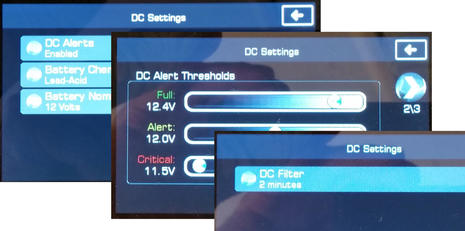 The Insight can be easily configured for one of several standard battery types or you can custom set Full, Alert, and Critical thresholds. Moreover, to avoid false alerts and alarms due to transitory voltage spikes — an annoyance I’ve seen with other monitoring systems — Nick programmed in 30-second continuous voltage averaging before a “threshold transition” is declared. And once he came across an obsessive battery watcher (me), he added that customizable filter, which can be set from 10 seconds to 30 minutes. Finally, he recently added a six-hour voltage trend feature to the Nautic Alert web portal that each owner gets, and I’m already using it to diagnose a possible issue.
The Insight can be easily configured for one of several standard battery types or you can custom set Full, Alert, and Critical thresholds. Moreover, to avoid false alerts and alarms due to transitory voltage spikes — an annoyance I’ve seen with other monitoring systems — Nick programmed in 30-second continuous voltage averaging before a “threshold transition” is declared. And once he came across an obsessive battery watcher (me), he added that customizable filter, which can be set from 10 seconds to 30 minutes. Finally, he recently added a six-hour voltage trend feature to the Nautic Alert web portal that each owner gets, and I’m already using it to diagnose a possible issue.
But I don’t mean to make the Nautic Alert sound overly complex. In fact, it’s darn easy to set up and use. But if you do poke around under the hood, I think that you, too, will be pleased with how much careful engineering has been done. And that applies to power consumption as well. The Nevata is rated at 20 milliamps (0.02 amps) maximum draw on 12 volts, and I have verified that the Insight in my real situation uses significantly less than its rated 200mA with screen on (at 680 nit maximum) and 80mA with screen (automatically) off.
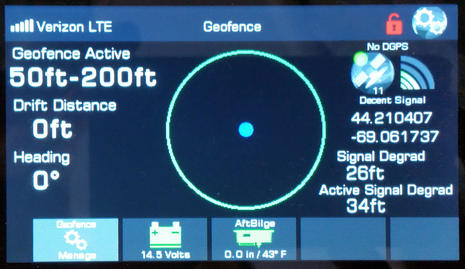 So it’s no surprise that the Nautic Alert geofencing is also sophisticated. Specifically, the software watches the GPS receiver’s perceived accuracy and adjusts the minimum geofence radius set to avoid false alerts. Of course, I had to push that concept, too, as a reliable remote anchor dragging alarm would be very nice indeed.
So it’s no surprise that the Nautic Alert geofencing is also sophisticated. Specifically, the software watches the GPS receiver’s perceived accuracy and adjusts the minimum geofence radius set to avoid false alerts. Of course, I had to push that concept, too, as a reliable remote anchor dragging alarm would be very nice indeed.
Interestingly, when set to the minimum 50 feet — less than recommended without Nautic Alert’s external GPS receiver, which I don’t have — I got a geofence alert that soon cleared itself at about the same time every morning while Gizmo was at her fixed fall berth. We concluded that the changing satellite constellation and the many local obstacles managed to align just enough to foil Nick’s algorithms, so he modified them in the latest firmware. The real test will come with spring and a chance to anchor out (at least where there is cell service). I’m quite hopeful and love the concept of one anchor alarm that will work whether I’m sound asleep up forward, hiking an island, or at a restaurant.
I’ll note that geofence alarming does not have to be precise to catch a boat thief, that it can also be useful if your boatyard moves or launches your boat without telling you, and that Nautic Alert will soon add tracking to its bag of tricks.
 I could go on and on, but here’s a photo illustrating how a Nautic Alert platform user sets up a phone for text alerting and data inquiries. It’s done right, of course, — the system sends the phone a verification code that has to be entered on the Insight — but it’s easy via the general setup menu always available under the gear icon. In this particular case the phone number had already been set up once, hence the early January “conversations,” but I had to do it again after the firmware update.
I could go on and on, but here’s a photo illustrating how a Nautic Alert platform user sets up a phone for text alerting and data inquiries. It’s done right, of course, — the system sends the phone a verification code that has to be entered on the Insight — but it’s easy via the general setup menu always available under the gear icon. In this particular case the phone number had already been set up once, hence the early January “conversations,” but I had to do it again after the firmware update.
Tip useful for any text-based monitoring system: The phone number I’m using here is actually a free Google Voice number, not my cell phone number. That way I can also converse with the Nautic Alert via email, using my phone or most any connected device, and my phone texting is a separate thing (unless I also register its number).
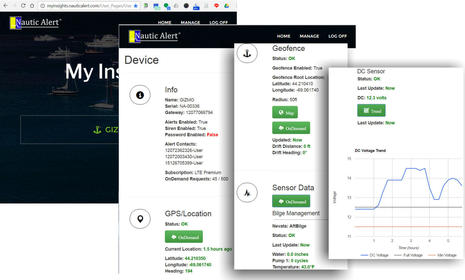 Here’s a collage illustrating what I can see and do on My Insight portal, which just went live recently. Note that it is a web app, no downloads necessary, and it works fine on my phone, tablet or PC. The time stamping of the six-hour DC Voltage Trend adjusts itself if you have not tapped the green button to request an update recently, but in this case I had just come home from a boat project session during which I ran the engine — mostly for warmth, the dang boiler still isn’t completely installed — and then the charger.
Here’s a collage illustrating what I can see and do on My Insight portal, which just went live recently. Note that it is a web app, no downloads necessary, and it works fine on my phone, tablet or PC. The time stamping of the six-hour DC Voltage Trend adjusts itself if you have not tapped the green button to request an update recently, but in this case I had just come home from a boat project session during which I ran the engine — mostly for warmth, the dang boiler still isn’t completely installed — and then the charger.
Obviously, I’m a big fan of boat monitoring generally and Nautic Alert specifically. So I’m quite excited about what’s unfolding this year. Since this October Panbo discussion, I’ve installed the very impressive GoFree Track hardware system, am seeing solid WiFi performance (the “global” cell service doesn’t include Camden, but Camden is quite odd that way), and I’m keen to test the soon-to-beta Vessel service beyond the very basic WiFi SD level. I also hope to try the Verizon version of Yacht Protector (right, the “global” GSM version doesn’t work here), and while Siren Marine’s MTC Connected Boat was delayed, it’s purportedly in production now and I will get to test it. Plus, I’ve reinstalled Boat Command and it remains a reliable and notably cost effective remote system. Gizmo may become the most monitored vessel on the planet?
If remote monitoring is as valuable as I think it is, all this activity has got to have an effect in the marketplace. Still, though, some of these developers don’t get one easy aspect I find highly desirable. Maybe it makes more sense emotionally than rationally, but I’m convinced that a good system doesn’t just tell you when things go wrong; it delivers the good news, too. Hence, the last Nautic Alert phone screen below. The top message is a regular alert (and speaks to the power issue I’m trying to diagnose). The second text is simply the “I’m OK” message I can get automatically every day simply by texting “Status On” to the Insight once at the time of day I prefer. It makes me feel good.
Finally, if not already obvious, the Nautic Alert Platform could be easily extended to sensors beyond the essential bilge, GPS, and battery. In fact, if you’re coming to the Miami International Boat Show next week, you can ask Nick Velado about that yourself. He’ll be demonstrating his excellent work at booth C284 in the electronics area, thanks to the good folks at Atlantic Radio/SatPhone Store.


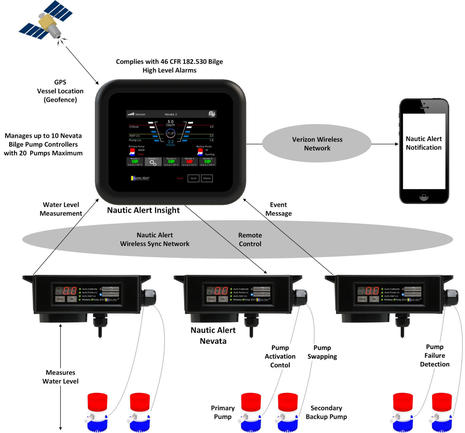

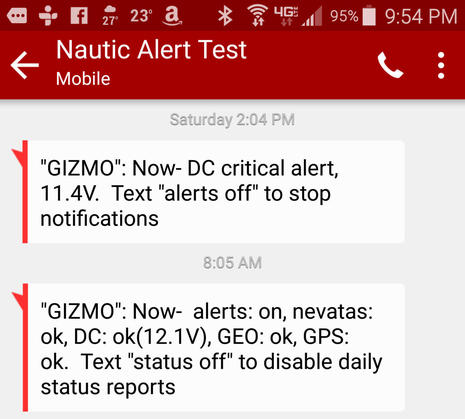



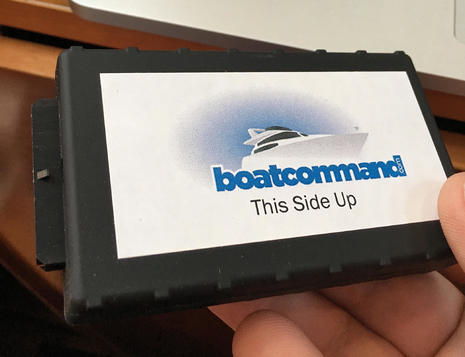








Ben,
Seems like there are a lot of players in this market now, as you covered near the end of the article.
This system looks really nice, especially the slick display panel, but what I’m having a challenge with is the cost. The base unit looks like $996 or $1365 when not on sale. Compared to Boat Command & Siren, that’s double or triple (or more).
The display panel is nice, but I don’t know if I could justify that extra cost just for that piece.
The bilge management piece looks far more developed than anyone else I’ve seen, so that’s definitely worth it if you need that level of bilge control.
I also 100% agree with you on status messages. Boat Command folks still do not have this feature to let you know their system is working, and I think it is a critical requirement to gear like this, not a nice to have.
I’m glad there are so many players here, some of which integrate with existing systems on board (Gofree) and look forward to lower prices and more feature competition!
Hi Steve,
I’m really glad you brought up the points that you did. As the design engineer for the Nautic Alert Platform, this is a great opportunity to better explain some technical details of the system. In terms of the costs, the answer for this is simple, we want the absolute best solution possible for the type of customers that demand nothing less, which includes no consumer grade components, all industrial or better.
For instance, when Ben received the Insight, we were the only monitoring solution he had evaluated that delivered any cellular connectivity in his marina, and as far as I know, this may still be the case. Using the latest LTE technology on Verizon’s network, he instantly had 4 to 5 bars of signal strength. We could have saved a lot of money by choosing a 3G or 2G modem, or another carrier, however, with the upcoming sunset of 2G and 3G network coverage, and other carrier coverage options, we wanted a solution that would guarantee connectivity for our customers for another 10+ years and have the best coverage.
Another key factor involved here is the brains behind the operation. We engineer the entire solution, not just parts of the solution, which includes the CPU components. For us, having the absolute lowest power consumption available, and being able to support solar panel setups, was necessary. Also, with needing to operate in a harsh environment, having nearly no heat footprint was essential for longevity of the internal components.
A third costly component for the Insight is the custom display. As you mentioned, this has a cost. However, in our case, we could have cut corners in several ways to make this less expensive, but we didn’t. The glass thickness is over-engineered, well beyond the normal thicknesses commonly used. The touch interface is custom designed to provide sleek capacitive touch buttons for an enhanced user experience. No mechanical buttons and no resistive touch screen.
Another way we could have saved costs would have been to offer Wifi in place of cellular or the soon-to-be-release Iridium coverage. We didn’t do this for a very specific reason. Our product offers OnDemand two-way communication services. When a customer wants data, we give them actual data from the device, live, in real-time. “OnDemand” data is not periodically sent to a server, then relayed to the customer, it comes straight from the device, whether over LTE or Satellite. In order to maintain a fluid and exceptional user-experience, we’ve opted to only offer the Insight with LTE or Iridium for the current release.
Additionally, excellence in engineering requires attention to detail. The amount of fuzzy logic built into the Insight is extraordinary. When we designed the DC monitoring feature, for example, we considered the load transients from periodic devices, such as bilge pumps and other devices, and wanted to ensure that a cycling pump wouldn’t create a false-alert. As Ben mentioned in the review, most solutions don’t include a simple filtering and hysteresis of their data analysis, which can be annoying. We do, for the DC, GPS, Nevata, all of it. In fact, everything we do is measured and verified. While other solution rely on on/off switch mechanical solutions, such as float switches, we choose to use measured and verifiable technology. Afterall, the last thing you want when you’re getting on a plane is to get an alert that isn’t real.
The GPS used contains hardware not available in NMEA GPS solutions, and was cherry picked specifically because it gives the ability to ascertain an exact positional accuracy at all times. This is needed to provide to most precise anchor alarm out there for two reasons. First, it enables extremely precise movement detections. Second, it allows us to eliminate false positives as the signal degrades due to weather, obstructions, etc…
When we started this venture and began discussing with actual boaters and our and their experiences, there were several key experiences that formed our basic design requirements and principles.
In terms of the bilge management, there were a few noteworthy specific cases that we heard multiple times.
In one case, a 35 foot sailboat kept on a mooring ball, started to encounter a leaky through-hull. The primary pump kept up with the leak until the pump cycling frequency caused the overall power consumption to deplete the solar-panel setup, and a high-water alert was not issued, since the DC supply was depleted by the time water rose to the high-water float. The boat subsequently sank.
In another case, a 50 foot power yacht sprang a leak in an engine coolant hose, and the bilge pump started running continuously to keep up with the incoming water. The owner had no idea his engine compartment was being flooded and, and by the time he was notified of the high-water condition, incurred $20k in damages that needed to be repaired.
In a third case, the owner of a 55 foot center cockpit sailboat had a primary, backup, and high-water alarm present. All float switches failed, and upon entering his boat, noticed there was over 20 thousand gallons present that needed an immediate pump-out. Salvage claims were costly in this case.
In a fourth case, the owner of a 45 foot sailboat was notified of high water, but did not see the message. The boat needed an immediate pump-out, but because of the delay in time, the sailboat sank.
When we started investigating this more, we found that BoatUS identified that most issues involving water damages occurred at the dock and were not only preventable, but easily detectable. The problem was that most solutions were either unreliable, or unable to detect an actual issue in advance of a high-water condition. With the many yachts and sailboats that one would consider costly, a high water alert was simply unacceptable for these boaters, especially when they could have known of a developing issue all along.
The boaters we talked to that shared these experiences want to know what’s going on in the bilge at all times, down to 1/10 of an inch. A mechanical float switch, or anything submerged for that matter, was deemed unreliable and unacceptable, especially if it either didn’t work, or still created havoc and costly claims due to a flooded engine, ruined floor, etc… In the case of damages with a high-water alert, the cost differences are easily offset by the repair and recovery fees involved when you now have the time advantage to deal with a developing situation in the bilge.
Overall, we choose to create an elegant solution to a unique set of problems. We are not the lowest cost solution out there as you mentioned, however, the value-add of the overall system should hopefully provide compensation for that. Thanks,
Nick Velado
Thank you Steve and Nick!
I tend not to focus on price because there’s so much subjectivity involved. But one trend I’ve been noticing in consumer electronics, and marine, is competition in the value price range and then another distinct tier where quality, style, user experience, etc. have been given much higher priority than price. I talked about it here:
https://panbo.com/archives/2016/04/scanstrut_rokk_mini_premium_marine_mount_system.html
Personally, I think it’s dumb to buy something expensive largely because it is expensive, but some people do that. On the other hand costly quality, reliably, “it just works” etc. can seem like a very good value over the long run.
Truly excellent point Ben! When we priced the Nautic Alert, we made sure that we were not the highest priced option out there, and tried to be more in the middle, with an exceptional feature set.
It’s also noteworthy that it’s not exactly an apples to apples comparison when our system is compared to a headless alternative (no built-in UI) in terms of price, as there are costs associated with tablets and such needed to interface to those black-box solutions onboard that should be considered, IF that product supports a local interface. Some products only support remote functionality.
Our product features roles that allow an onboard user to make use of the anchor alarm, for example, while enabling someone else to see everything remotely, and keep all settings on the device password protected. This enables separation of onboard and remote functionality in a very clean fashion.
Excellent article and they look like like they’ve really nailed the bilge pump area.
For me, I can’t say enough good things about Boat Command. My Nonsuch 354 lives 350 miles away in San Rafael while we live in Las Vegas. Having immediate knowledge and warning via text, email and app when the bilge pump operates, shore power disconnects, battery voltage is off or someone steals my boat for $300 and $8.95 per month is incredible peace of mind. During the recent heavy California rain storms, for example, I knew exactly when and for how long the bilge pump ran keeping the bilge dry.
Comment to Steve: it would be great to know when the Boat Command is off-line. The way their system works, however, it updates every 8 hours to minimize the cellular charges to them. Online status would require a “heartbeat” connection to their servers. But I would expect to see lower-cost expanded IoT services by the carriers that makes that economical.
Ok, for anybody who wants to do it the cheap way a float switch and this nifty device would do:
https://www.amazon.com/RedSun-Tracker-Vehicle-Tracking-Control/dp/B00VTF7OSQ/ref=sr_1_1?ie=UTF8&qid=1486748366&sr=8-1-spons&keywords=TK103B&psc=1
Thanks, Nonsuch. I’m a fan of Boat Command too, and the one thing Nick got confused about in his first comment is its cellular success for me. The original Boat Command using Verizon 3G (I think) worked fine here in Camden, and so does the current “international” model, which uses A&T 3G GSM/HSPA service. Text and email alerts from the boat are quick, and refreshing data from the apps fairly quick.
Boat Command’s AT&T success here in Camden is interesting because that seems to be the problem around here. AT&T voice and data does work for existing customers in this area, but it’s roaming and they won’t sell service to locals. I’m guessing that what happens with services like Vodafone Global — the one Navico GoFree uses — is that they have a deal for AT&T coverage but it does not include places where AT&T roams. Whereas Boat Command may have a direct deal with AT&T that doesn’t suffer that limitation. Incidentally, the T-Mobile that used to work here doesn’t anymore, though the coverage map shows otherwise. At any rate, Camden is quite odd this way in my experience, but Iridium sure seems like a more sure proof monitoring medium.
Incidentally, I have the same 8 hour Boat Command subscription you do, but the values on my BC apps reliably update automatically every 3 hours. Am I getting special treatment?
Hi Ben, I just checked mine on a day in February that was not affected by the California storms, which caused more frequent updates. Here are the times (This happens to be Battery Bank #1).
2/02/2017 10:03 PM 13.13v
2/02/2017 4:03 PM 13.13v
2/02/2017 10:07 AM 13.19v
2/02/2017 4:03 AM 13.07v
So it looks like I’m getting every 6 hours now. Used to be 8 from when I first installed it 18 months ago. I do have the original version which has not been swapped out which is probably Verizon. Maybe the IoT charges are dropping from the carriers already…?
Hi Chriggel,
There are a lot of challenges with the 2G/3G options, as you’ve pointed out. Here’s a quick link from AT&T that discusses their sunset of 2G coverage:
https://www.att.com/esupport/article.html#!/wireless/KM1069631
The problem is that in a 2G/3G scenario, a device may fallback to a 2G network without the end user knowing at all, and then, all of a sudden, with the sunset of 2G, it no longer works in that spot as the carriers phase out their 2G network. The carriers are already talking about phasing out 3G, although, there’s little public detailed info on this at this time as to who will do this and when, at least not that I can publicly comment on. 2G had much better coverage in marginal areas, and it was really disheartening for us early on when we found out this was all going away.
We found that the roadmap for coverage in the US for 2G/3G was somewhat murky from talking to the carriers, however, it was even more daunting when talking about international coverage. With so many carriers in so many places, we couldn’t get a clear cut answer on what the roadmap would be in various places, and decided that LTE was the only viable solution for cellular going forward, with Iridium to fill the global coverage map. As you pointed out, depending on who the carrier is, it may or may not work on this network or that one, etc. etc…
Also, LTE signals work much better through buildings and boats, and feature much farther ranging coverage than 2G/3G bands. We found that an external antenna was not necessary for LTE in most situations, simplifying the installation process. Of course, the downside is the upfront cost, but with a known roadmap of coverage, it seems like the best option for us and our customers.
I also just want to clarify that I do believe BoatCommand is a fantastic value, and makes sense for a lot of boaters–don’t want to take anything away from their product at all. We tend to have a different type of customer with different needs from what they, and others, offer.
Nick,
thanks for your link about 2G/3G sunset in the US. That is pretty soon! Here in Europe it is interesting to know, that the network operators want to keep a small band of 2G frequencies and ditch the 3G instead! The authorities have been pretty relaxed lately with the specific use of each band so that old frequencies which used to carry 2G/3G traffic only can also be used for LTE. The network operators are aware of all those small M2M 2G terminals which are fine for transmitting very reliably short data packets while having a very small power demand. Those power saving terminals never really existed for 3G. So as you guys in the US are forced to develop power saving M2M LTE terminals this will benefit us in the rest of the world, too 🙂
If you’re in a marina with wifi or have a mifi access point on your boat and just want bilge monitoring there are also much less expensive domestic sump monitoring solutions. They monitor the water level and send you text message alerts if an alert threshold is exceeded or if the system goes offline.
For example this one is $150 and free annually for the first 2 years ($9/yr after that), can run directly off of 12V power, and has a nice web monitoring solution with customizable alert thresholds for the various sensors and water level graphs. I’m in the process of installing it on our boat.
https://www.level-sense.com/products/level-sense-pro
It’s definitely not a high end marine grade solution but it should do the job of keeping an eye on the bilge while I’m away. I’ll be curious to see how it holds up over time but for the price it’s worth a shot.
For a really inexpensive solution that will handle temperature, high water and intrusion, assuming you have ethernet of some sort, look at these Wireless Tags:
http://wirelesstag.net/
I run their tag manager to a cheap ethernet to wifi converter (designed for TV sets) and then to the marina wifi. You can get email or text alerts when anything is amiss and check your temperature and such from your phone. The one thing missing is DC voltage, but it is now possible to cobble together an AC voltage monitor by taping their light sensitive tag to an LED night light. Anyway, these work very nicely for under a hundred dollars.
Hi Steve, we just restructured our pricing models based on customer feedback like yours and others. In doing so, we were able to reduce costs to the end user and make our product truly much more competitive. We just announced our spring sale today based on these numbers, which now includes a lower cost, bundled options, data included for the first year, and free shipping. Definitely appreciate all feedback, as that’s the only way we can continue to improve. Thanks,
Nick
NonsuchGuy,
I have the every hour update frequency from BoatCommand which gives me a report every hour, along with unlimited on demand reports, and unlimited alerts.
That’s only $270/year which I consider paltry for the peace of mind and protection that it provides.
What I think is weird is the limits vendors have put on the frequency you get data. Once every 8 hours is way too infrequent for me. Having a decent amount of background on a personal level (my day job) in the mobile industry, there is definitely some overcharging or limits going on here that don’t make sense.
If you pay $22/month for a text/data only plan (what BoatCommand would work out to), every provider in the US would allow you to have unlimited texts and enough data a month that you should have 1 hour granularity without any issues.
Do vendors just send too much data back to their servers, running over that data limit? Bad software design? Too chatty?
An end user like us would never get a $22/month plan for sure with those limits, that would have to be part of a bigger global plan, but even at $20-40 a month on our end, you’re never going to run into any of the artificial limits that seem to be in place.
What will make this even more interesting is the last couple of weeks where all major US carriers announced unlimited data, talk and text (with caveats of course). I have plans with all of them myself (don’t ask) and am so happy that competition has finally driven this whole argument of charging for tiny amounts of data out of the equation. I hope this flows down to the monitoring market as well.
Hi Nick,
Thanks for the initial reply and follow up post on the costs changing. That is definitely great news!
Cell signal isn’t worth a huge cost difference. There are other ways to solve that on the product side – perhaps providing a SIM slot that allows an end user to choose the network they are on instead of a fixed provider. Almost all manufacturers of this sort of solution have restricted this, even back to the Boat Sense system I had in 2006, and it’s frustrating. We get that you negotiate a contract with someone, but why not let the user choose their own plan, for a service they already likely have for their phone or boat. Most all of the sailors I know in the Seattle area are no longer using WiFi and have LTE devices on their boats for internet access – adding another line to their plan is trivial. Maretron’s SMS 100 did this…
The engineering of the unit obviously drives the costs up, and I understand that, working for a hardware vendor myself. I also understand the need to control components and software/hardware mating so that you have a reliable, programmable, low power system. My only point is that others have done it in very similar ways for much less. They may not have as robust control locally, and none except Maretron have a local screen as beautiful as yours, but it comes down to the features that an end user absolutely requires.
I completely agree with you on the WiFi side. It would be nice to offer it for people who don’t want a monthly subscription, but they would have to realize there is no backup if their WiFi dies in some way. Of course a daily “I’m here” text would probably be a way to solve that – if you remembered that you didn’t get it, then you know something is amiss. Still not optimal though for sure.
I think a great idea would be to have a hybrid, which is what I do with my home-grown solution. It uses WiFi if it can detect it’s working, otherwise, it falls back to LTE. That way I send data updates over WiFi when possible, saving a lot of use of my LTE plan, but I still have it as a fail safe if the LTE side fails.
Engineering of features like better handling of transients is well worth it. I have four devices on my boat right now that send me alerts, and I get many false positives that have me freaking out at least once a month. I would definitely pay more for better engineered software/hardware that helps with this.
GPS is great, but my phone, and many other GPS devices, can get very accurate and repeatable locations. I wouldn’t pay more for that particular piece.
I also 100% agree about bilge management. It’s one of the primary ways people have massive damage or lose their boat altogether. The problem is that very fact – it’s so common to have these problems because people don’t realize they need to invest in better pumps, floats, wiring, maintenance routines, etc. How are they going to be able to get over the barrier of a $400 bilge pump controller is I think your biggest challenge. Getting them to buy a $100 pump or a $25 float is impossible, so how can you convince them this investment is worth it?
That being said, having had the time to research Nevata and talk with some folks who have used it, it sounds like an amazing product.
I would agree with Ben that this seems to be the best engineered system out there, not just for bilge management, but general boat monitoring. I’d love to have one on Grace – who knows, maybe I need a 5th system!
This is a bit too expensive for those of us with a single bilge and bilge pump. I wonder What would it look like in lower component and install costs if it used a Johnson Ultima switch in the bilge (no moving parts) instead of ultrasonics, no display at all (smart phone app to configure), and maybe loose the GPS?
Like a completely different product, Dan. Now at about $1,100 for the system I’m testing, including 1 year service, Nautic Alert is still a premium product, but I can think of many ways to spend similar money on or around a boat.
Meanwhile, the peace of mind I felt leaving my dear boat surrounded by ice in a blizzard was nearly priceless. I didn’t actually use the system much while I was in Miami — except for showing off how I could get an instant text back with bilge water level and temp — but that’s because I’m so confident that I’ll be alerted to a problem and also because I got that “I’m OK” status message early every day like clock work.
This last week I used Nautic Alert a lot while doing a controlled draw down test of the Firefly batteries, half a bank at a time. Boat Command was also useful with its automatic 3 hour DC reporting, but with NA I got 15 minute interval graphing. I’d worried myself into thinking that one of the new batteries was troubled, but now I think that I’m just not used to the low voltage levels these batteries can be safely used at.
I agree with Dan on the cost for a single bilge pump. That’s the situation I have given the layout of my sailboat, and it’s hard to stomach the overall cost just for that one pump.
However, I also agree that peace of mind with a quality, reliable system is an important thing to have. I’ve been trying to design my own home made one since the 90’s and have tested every one in existence that I can afford / get my hands on.
It definitely looks like this one is the next best thing.
Some great comments here, a couple of things worth noting about the system…
Nautic Alert specializes in advanced early detection of issues using measured data to make decisions, as opposed to on/off type of sensors, which means greatly reduced false positives. You, like our system, need information to make an informed decision when an alert occurs. This includes things like knowing the exact amount of water in the bilge, what your DC system “looks” like prior to a low voltage condition, what your positional accuracy is etc… This is one of the advantages of the system.
We realized that some people want data on demand, and sending it at a pre-set rate was insufficient. A BIG difference between our on-demand and other systems is that we don’t send our data to a server periodically, then give you the latest reported snaphot when you ask for it, we actually connect you with the device itself and provide you current data in real-time, from the source. On-Demand may not necessarily mean real-time with other systems. Because we do this in a 2-way real-time way, we cannot support customer-supplied SIMs or Wifi, as that would only be sufficient for one-way reporting without the customer needing to take additional measures, if it’s possible at all. Our branding requires we keep it simple, and it simply works, which would not be the case for this feature if we used alternative communication forms or networks we don’t control. Also, because our system is both a controls and monitoring solution, we must have two-way communication to the device at all times.
When I’m out sailing, I like to periodically grab the current DC trend data to be able to see how quickly my batteries are depleting, and ensure I have the confidence to continue to run the electronics, radio, electric winches, etc… without running into unexpected issues later when I go to crank my motor. A low voltage alert would not give me the insight I need to make an informed decision on this. This is just one example of how our system supports on-demand and can be used for purposes beyond remote monitoring. I grabbed a screen shot of data from my last sail, and the data 6 hours before and after looked identical. All of the real information occurred between the 6 hour interval. As Ben mentioned, we trend data based on a 15 minute sample window, which is really useful for a number of situations where a 6 hour sample, for example, will not do.
Our Nevata controller is a replacement for a float switch, and not a pump. It’s designed to work with most existing pumps without needing to change anything else. We typically see one of two common use cases for this. In the first scenario, the user has between 2 and 3 bilge compartments, and the value of their boat is such that waiting for a high water alert would far outweigh the cost of the Nevata. These are typically power yachts in the $200k range into the millions. For them, if they wait to get high water, they’ve partially flooded their engine, flooring, etc… and getting the early detection of bilge issues with redundancy is key.
The second case often involves a difficult bilge compartment, and/or the mismatch of a small primary pump and a larger backup pump. In these cases, the bilge may be very deep or too small to physically get pumps into or work with. Because Nevata can auto-switch from a small primary to a large backup, and enables a user to keep the pumps in a separate location, they can use a self-priming diaphragm style pump and get a lot of flexibility. A lot of people like a specialized primary pump to keep the bilge really dry, but this is not sufficient for a situation where higher pumping capacity is needed, and Nevata gives the flexibility to handle this.
Many boaters will be OK with getting a high-water alert and/or relying on a float or other switch submerged in the bilge. There are lots of cheaper solutions that can do this, however, for the boater that wants the time advantage by knowing the second there’s an issue, we fill that void very well.
New product announcement–hear about it on Panbo first. We’ll be releasing this announcement publicly to the marine industry next week, Panbo gets the first sneak-peak at it.
Our X2 platform is the early detection platform that continues to introduce innovation and new technology the marine industry hasn’t seen before by adding some significant functionality, all building on the previous Insight offerings.
Global GEOS Emergency and SOS monitoring with two-way communications and messaging, and a concealable short range personal emergency transmitter that can be used on-board, in a dinghy, in a man-overboard scenario, or even from a beach within short range of the boat. Includes world-wide coverage when used with an Iridium-Insight.
Microwave-based intrusion detection that offers early-detection of intruders before they board a boat, before they enter a boat, or during boat entry. Designed for harsh-environments where vibration, swaying lines, wind drafts, rocking… are present and make traditional passive infrared technology unreliable or impossible to use. Safeguards motors, dinghys, and personal belongings. Ideal for staying on-board and concerned about intruders, or for away-mode operation. Includes stealth-mode operation and other features custom designed for marine.
Multi-bank DC monitoring and trending. Early detection of battery-related issues expands with trending view data to capture multiple battery banks with our XPulse sensor.
Vessel tracking interface that automatically determines your tracks and provides easy play back. Uploads data live, and even buffers track data when out of cellular range. Very useful feature for enabling friends and family to always know where you are, which includes on-demand real-time location access too.
Shore power detection
Integrated text message interface for communicating with any mobile number.
All this builds on the existing platform offerings, which includes the intelligent Nevata bilge controller designed to replace a float switch from above and detect issues with plumbing, pump, and electrical well in advance of a high-water condition, as well as the high-precision anchor alarm designed to detect unexpected movement in as little as 50 feet, and automatically adjusts to changing signal conditions for superior accuracy and reliability.
We’re working with Ben now to get Gizmo up-to-date on this platform.
Nick
Thanks, Nick. X2 sounds like a lot of interesting improvements over the Insight/Nevata system that has continued to serve me well. But I want to clarify that while X2 looks like the original Insight, it is in fact a new more powerful model with a significantly higher price, especially in combination with the XPulse sensor interface and added sensors. Readers may find these two pages useful to understanding the X2 story:
https://www.nauticalert.com/nautic-alert-platform-comparison/
https://shop.nauticalert.com/category-s/125.htm
On the other hand, I just noticed that the price of the Nevata bilge sensor/controller and the standard Insight are both reduced from what I quoted in the original entry (and I corrected those dead links). So the system described in detail above, plus some improvements like vessel tracking now costs $1,175 total (plus Verizon service). Nice!
https://shop.nauticalert.com/category-s/124.htm